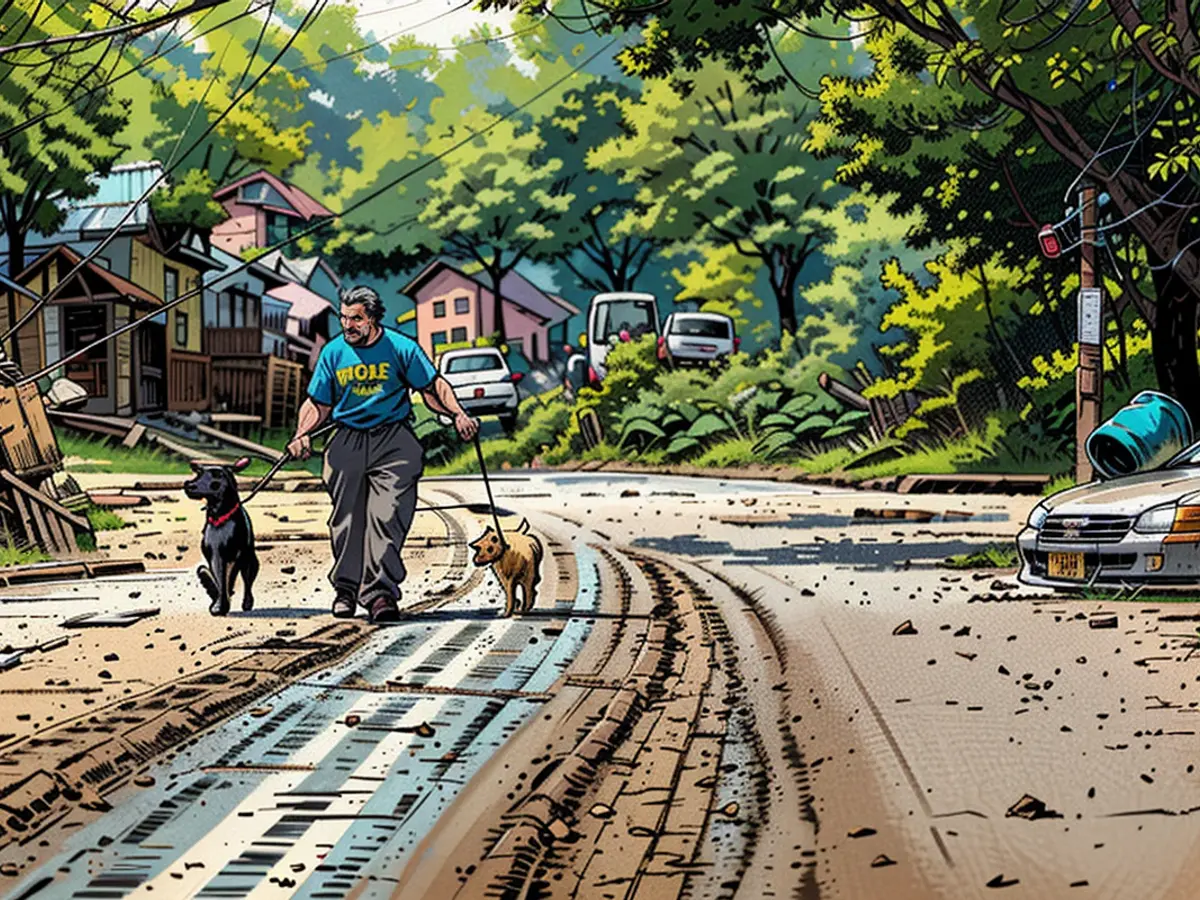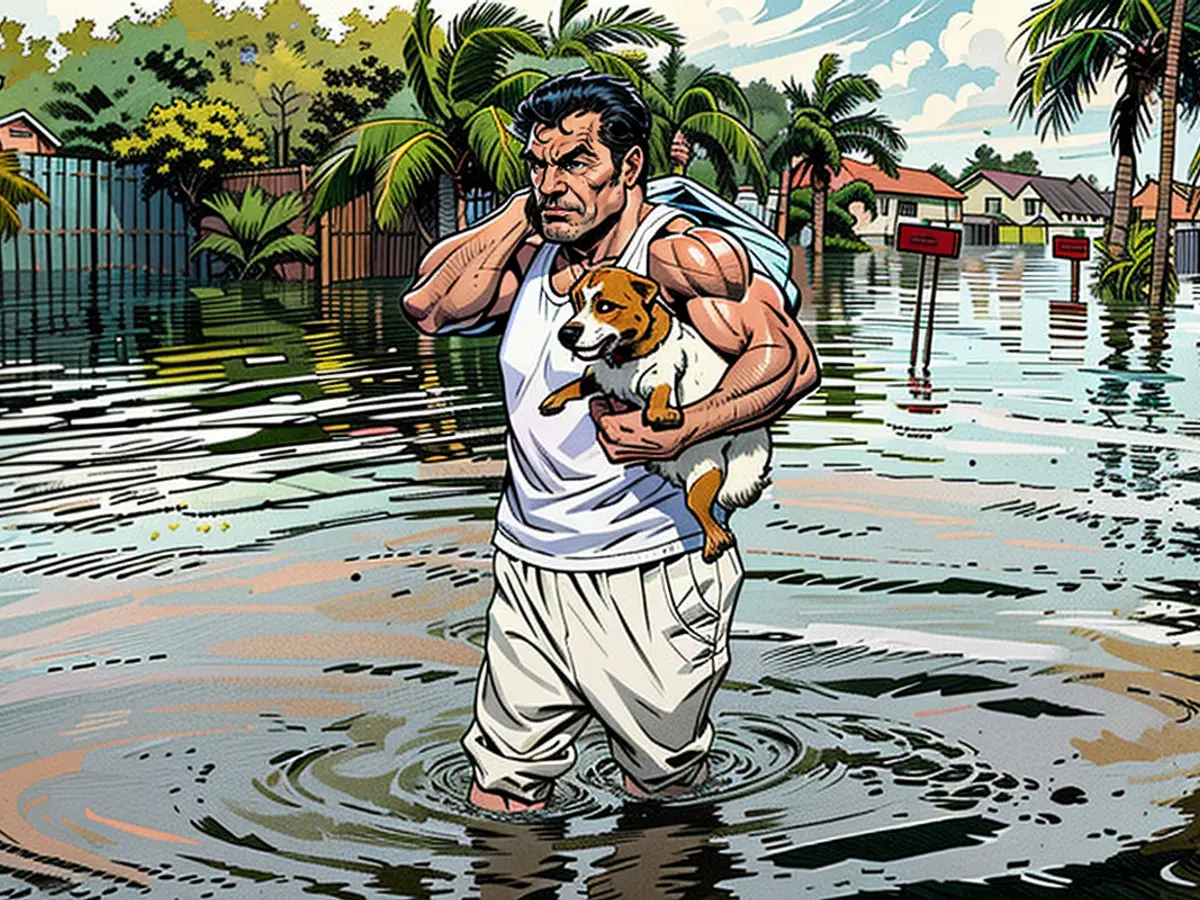IS AMERICA READY FOR DISASTER?
- This CNN Opinion series brings you expert viewpoints on how we can better prepare for catastrophes:
- The billion-dollar disasters around the corner
- In the blink of an eye, a wildfire changed everything
- It’s time to evacuate. But why won’t people flee the encroaching disaster?
- Our disaster responders are exhausted. This puts Americans at risk
- Many people can’t physically flee disasters. Too often, we fail to help them
- ‘The big one’ disaster could happen in our lifetime. Can we even be ready?
Opinion: We’re neglecting pets in disasters — with tragic consequences
In the aftermath of Katrina, the Pets Evacuation and Transportation Standards (PETS) Act of 2006 was passed. The PETS Act requires that states and localities include pets in their evacuation and sheltering plans. However, development and implementation of pet evacuation and sheltering plans during disasters remains widely insufficient, if it is even addressed at all.
At least 15 states do not have any provisions for the evacuation, rescue and recovery of pets during disasters, according to Michigan State University’s Animal Law and History Web Center. At the local level there appears to be even more inconsistency, with many communities having little to no guidance about pets in disaster plans.
As a veterinarian who advocates for stronger disaster planning, in 2015 I deployed to the Valley Fire about two hours north of San Francisco to assist with rescuing pets in the evacuation zone. The wildfire killed four people and charred more than 76,000 acres while destroying nearly 2,000 structures.
I saw with my own eyes the consequences of owners not being able to take their pets with them, including dozens of cats, dogs, horses and chickens with singed coats and feathers hiding in the ashes of their homes. Worse still were the numerous burned bodies of pets that had not been able to be safely evacuated.

As we have seen time and time again, failure to include pets in disaster evacuations not only affects the pets that are left behind, but it is also an issue of public health and safety.
One of the most common threats to human safety is evacuation noncompliance, when people refuse to follow orders to evacuate and instead remain in hazardous areas. This is particularly prevalent with pet owners. This refusal to leave may be due to several factors, including that pet owners may be told that they cannot take their pets with them, are unsure where to take their animals since many emergency shelters and hotels do not allow pets, or lack access to a way to transport pets or supplies such as leashes and carriers.
During Hurricane Katrina, some pet owners were even threatened with arrest before they were convinced to evacuate their flooded homes without their animals. It is estimated that 20-30% of all evacuation failures are due to pet ownership.
Evacuation noncompliance not only puts civilians in danger, but also first responders who must enter dangerous areas to try to evacuate those who have refused to leave.
Premature return to evacuation sites to find pets left behind is another problem during and after disasters. It has been estimated that up to 80% of people who prematurely re-enter an evacuation site do so to rescue a pet. One extreme example occurred in the 2009 bush fires in Victoria, Australia, when a dog owner jumped out of a police rescue helicopter’s harness to return to her dog. (Both of them thankfully survived.) More commonly, pet owners will sneak back into active evacuation sites to rescue their pets, risking injury and even death. First responders who try to help them are similarly endangered.

Additionally, unauthorized animal welfare groups or well-meaning volunteers frequently enter evacuation zones to try to rescue animals, which can result in a chaotic mix of untrained people entering unstable areas. It also complicates owner reunification when there are multiple rescue groups involved, as there is currently no comprehensive database where owners can search for lost pets. These animals may be rehomed with other families or even euthanized if owners are unable to locate them.
The consequences of losing a beloved pet during a disaster can be devastating. An overwhelming 97% of pet owners consider their pet a part of their family, and pets help both children and adults cope with stress and anxiety. The loss of a pet can cause stress, grief and depression, particularly when owners are forced to abandon their pets in an emergency and are later overcome with guilt.
Pet loss because of forced abandonment can negatively impact short and long-term mental health. Possible consequences include psychological trauma and stress, an increased risk of post-traumatic stress disorder (PTSD) and worsening of depressive symptoms. In one study, pet loss resulted in higher levels of PTSD and depression than the loss of one’s home. Allowing pet owners to evacuate their animals may prevent significant psychological distress and can strengthen the emotional resiliency of evacuees.
The basic needs of health care workers who are needed badly on the front lines should also be considered during a disaster. Health care workers have cited pets, family and personal safety as more important than food, water, sleep and shelter during a disaster. Studies have shown that not having suitable arrangements for pets is one of the foremost barriers to health care workers being willing to work. Recognizing this need, after Hurricane Katrina, Tulane University Hospital and Clinic in New Orleans created a pet care center in the hospital’s parking lot for employees’ pets.
A 2021 ASPCA survey found that while 91% of pet owners said they would plan to evacuate with their pets in the event of a disaster, 47% of owners who previously evacuated during a disaster had left at least one pet behind.
These findings underscore the vital need for more robust pre-disaster planning to prevent pets from being left behind during the panic and stress of an unfolding crisis.
It is crucial that pets be considered in community and state disaster plans, that first responders are trained to tell evacuees to take their pets with them and help when able, and that pet owners are aware of the need to create a family evacuation plan that includes their pets. There are many ways in which animals can be safely sheltered during disasters, including in pet-friendly evacuation shelters, at hotels or in temporary animal housing facilities. Owners should be sheltered with or near their pets when possible, which reduces stress for both pets and people and allows owners to provide care for their pets, making pet-care facilities much less expensive to run.
Safely evacuating pets is too often an afterthought. Safely evacuating people and their pets goes hand-in-hand, and it is a matter of public health and safety that pet owners, first responders and emergency planners start to think this way.
In the discussion of disaster preparedness, it's important to note that failure to consider pets in evacuation plans can lead to public health and safety issues. This is particularly prevalent when pet owners refuse to evacuate due to concerns about their pets.
According to some studies, as many as 20-30% of all evacuation failures are due to pet ownership, putting both civilians and first responders at risk.
In light of these opinions, it's crucial that pets be considered in community and state disaster plans, and that first responders are trained to help owners evacuate their pets when possible. This not only benefits the pets but also contributes to the overall safety of the community during a disaster.







